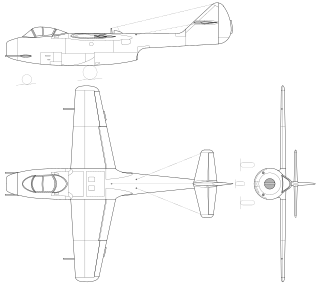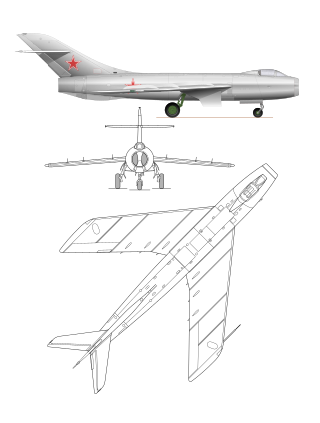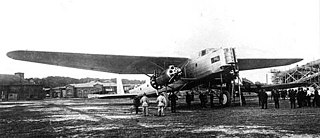Related Research Articles

The Sukhoi Su-2 was a Soviet reconnaissance and light bomber aircraft used in the early stages of World War II. It was the first airplane designed by Pavel Sukhoi. The basic design received an engine and armament upgrade (Su-4) and was modified for the ground-attack role (ShB).
The Yakovlev Yak-26, OKB designation Yak-123, was a Soviet tactical supersonic bomber aircraft flown at the Tushino air show on 24 June 1956. The model did not enter service.

The Sukhoi Su-9 was an early jet fighter built in the Soviet Union shortly after World War II. The design began in 1944 and was intended to use Soviet-designed turbojet engines. The design was heavily influenced by captured German jet fighters and it was subsequently redesigned to use a Soviet copy of a German turbojet. The Su-9 was slower than competing Soviet aircraft and it was cancelled as a result. A modified version with different engines and a revised wing became the Su-11, but this did not enter production either. The Su-13 was a proposal to re-engine the aircraft with Soviet copies of the Rolls-Royce Derwent turbojet as well as to modify it for night fighting, but neither proposal was accepted.
The EF 132 was a planned jet bomber, under development for the Luftwaffe during World War II. It was the last aircraft project development undertaken by Junkers during the war, and was the culmination of the Ju 287 design started in 1942.

The Yakovlev Yak-25 was a Soviet military aircraft, an early turbojet-powered fighter aircraft designed by the Yakovlev OKB. The designation was later reused for a different interceptor design. Tasked by the Council of Ministers in a directive issued on 11 March 1947, with producing a straight winged fighter similar to the earlier Yak-19, but powered by a Rolls-Royce Derwent V, OKB-115 swiftly produced the Yak-25, which blazed several trails as the first Soviet fighter with a fully pressurised cockpit, air conditioning, jettisonable canopy, and hydraulic airbrakes on the fuselage amongst other innovations.

The Lavochkin La-150, was designed by the Lavochkin design bureau (OKB) in response to a 1945 order to build a single-seat jet fighter using a single German turbojet. By this time both the Americans and British, as well as the Germans, had already flown jet fighters and the single Soviet jet engine under development was not yet ready for production. The design was completed quickly, but the construction of the five flying prototypes was protracted by the factory's inexperience in building metal aircraft. The aircraft made its first flight in September 1946, but proved to require extensive modifications to meet the Soviet Air Forces' requirements. These took so long to make and test that the aircraft was essentially obsolete by the time that they were completed. Even one variant with a much more powerful engine was inferior to other aircraft that the OKB had under development and all work was terminated in 1947.

The Sukhoi Su-6 was a Soviet ground-attack aircraft developed during World War II. The mixed-power high-altitude interceptor Su-7 was based on the single-seat Su-6 prototype.
The Sukhoi Su-8 or DDBSh was a Soviet prototype ground-attack aircraft of World War II.
The Sukhoi Su-5 or I-107 was a Soviet mixed-power prototype fighter aircraft built toward the end of World War II.

The Sukhoi Su-12 was a prototype Soviet reconnaissance and artillery spotter aircraft developed during World War II.

The Sukhoi Su-15 was a prototype Soviet all-weather interceptor which never reached production.

The Sukhoi Su-17 was a prototype Soviet fighter. The name was later reused for an entirely different fighter-bomber, see Sukhoi Su-17.

The Ilyushin Il-40 was a two-seat Soviet jet-engined armored ground-attack aircraft. The first prototype flew in 1953 and was very successful except when it fired its guns, as their combustion gasses disturbed the airflow into the engines and caused them to flameout or hiccup. Remedying this problem took over a year and involved the radical change of moving the engine air intakes all the way to the very front of the aircraft and repositioning the guns from the tip of the nose to the bottom of the fuselage, just behind the nosewheel. The aircraft, now resembling a double-barreled shotgun from the front, was ordered into production in 1955. Only five production aircraft had been completed before the entire program was canceled in early 1956 when the VVS discarded its close air-support doctrine in favor of tactical nuclear weapons on the battlefield.

The Grigorovich TB-5 was an experimental heavy bomber designed and tested in the Soviet Union in the early 1930s. Designed as a competitor for the Tupolev TB-3, the TB-5 was intended to be powered by two FED 24-cylinder X engines of 746 kW (1,000 hp) each. When these were canceled, the underwing pods were revised to each house a pair of Bristol Jupiter engines in a push-pull configuration. Despite projected performance inferior to TB-3, it was hoped that TB-5 would gain an advantage by using less metal thanks to its mixed construction of fabric-covered metal frame.

The Kalinin K-7 was a heavy experimental aircraft designed and tested in the Soviet Union in the early 1930s. It was of unusual configuration, with twin booms and large underwing pods housing fixed landing gear and machine gun turrets. In the passenger version, seats were arranged inside the 2.3-meter thick wings. The airframe was welded from KhMA chrome-molybdenum steel. The original design called for six engines in the wing leading edge, but when the projected loaded weight was exceeded, two more engines were added to the trailing edges of the wing, one right and one left of the central passenger pod. Nemecek states in his book that at first only one further pusher engine was added.
Tupolev TB-6 was a proposal by the Tupolev Design Bureau in the 1930s for a super-heavy bomber. Had it been built, it would have been the biggest-ever Soviet bomber and the largest aircraft by wingspan of its time, nine feet short of the 320 foot span of the Hughes H-4 Hercules, although the Scaled Composites Stratolaunch is now the biggest plane by wingspan.
The Alekseyev I-212 was a twin-engined, jet fighter designed in the USSR in 1947 at OKB-21. It was a two-seat variant of the I-21 designed in response to a requirement for a very long-range fighter issued by the Voenno-Vozdushnye Sily (VVS),, in 1946. Intended as an escort fighter, it was also designed for use as a night fighter and reconnaissance aircraft. No prototype was built, although some parts may have begun building before the project was completed.

The OKB-1 150 was a jet bomber designed and produced in the Soviet Union from 1948.
The I-218 was an attack aircraft designed and built in the USSR from 1947.

The Yakovlev Yak-1000 was a Soviet supersonic technology demonstrator intended to evaluate the aerodynamic layout and field performance of the cropped delta wing discussed in captured German documents in combination with the new Lyulka AL-5 turbojet. The tandem undercarriage proved to be unsatisfactory and there were serious flight stability problems related to the delta wing, enough so that it never flew after an accident during taxiing tests.
References
- 1 2 3 4 Gordon,Yefim (2004). Early Soviet Jet Bombers. Midland. ISBN 1-85780-181-4.
- 1 2 Shavrov, V.B. (1994). Istoriia konstruktskii samoletov v SSSR, 1938–1950 gg. (3 izd.). Mashinostroenie. ISBN 5-217-00477-0.
- ↑ Antonov, Vladimir; Gordon, Yefim; Gordyukov, Nikolai; Yakovlev, Vladimir; Zenkin, Vyacheslav; Carruth, Lenox; Miller, Jay (1996). OKB Sukhoi : a history of the design bureau and its aircraft (1st ed.). Earl Shilton: Midland Publishing. p. 69. ISBN 9781857800128.
- ↑ Gunston,Bill (1995). Osprey Encyclopaedia of Russian Aircraft 1875-1995. Osprey. ISBN 1-85532-405-9.